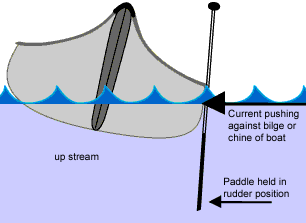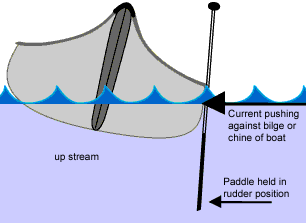Using the River's Currents to Propel Your Canoe
To become a fine canoeist in moving water, you must first learn how to use the river's energy to help propel your craft. Just like a sailboat using wind to move forward, a canoe uses current. The sailboat has a centerboard and sail to accomplish this; the canoe uses a paddle and its hull shape — not just power strokes.
You can reach an average level of proficiency with power strokes, but to become better, learn how to current-sail your craft. If you pull up a sailboat's centerboard or don't trim the sail properly, the boat will lose speed and drift downwind. Similarly, if you take your rudder out of the water during an upstream ferry, or don't maintain your boat angles and keep the canoe's edge set, the canoe will lose speed and drift downstream. Both your paddle and the canoe's edge give the water something to bite onto (see Diagram A). Although the edge created by your rudder stroke is obvious, the edge on your canoe isn't. Hard-chined boats like V- and flat-bottom hulls provide a better edge for the current to grab because of their shape. Rounder hulls have a more gentle edge, meaning there is less for the current to push against. Some boats, like the Dagger Ovation and Ocoee, have ghost chines that are hard to see, but provide bite in the current. Most whitewater canoes have excellent secondary stability, which allow them to be heeled over onto these edges.

Diagram A
Heeling your boat during your ferry: Both your paddle and the canoe's edge give the water something to bite onto. When turning left, heel your boat to the left to depress its chine as deep as possible.
When turning right, heel the boat to the right, and vice versa. When ferrying upstream, heel in the direction of travel (the same is true when surfing). This ensures that the chine is depressed as deep as possible and is using the river's currents (see Diagram B). Another hull feature that helps a boat turn is rocker, which, when the canoe is tilted on its side, creates an hourglass carving shape to help the boat turn.

Diagram B Entering an eddy: Cross the eddy line at 90 degrees and have the boat heeled over to the side you are turning.
Maintaining your boat angle during eddy turns, peel-outs and upstream ferries also helps tap into the river's energy. For ferries, leave the eddy with forward momentum, keeping your bow facing almost upstream and rudder in the water. Once you're in the main current allow your bow to open its angle; you'll feel your speed increase up until you're about 45 – 90 degrees to the main current. Maintain this angle and heel. When you're about to cross the opposite eddy line, open your angle to 90 degrees. Then press down on the opposite edge of the canoe to turn you upstream in the eddy. When ferrying upstream from river left to river right, put your left gunwale down. As you execute your eddy turn on the opposite side of the river, put your right gunwale down. This will eliminate half your strokes and provide more forward momentum.
When peeling out, follow the same procedure: Build forward momentum before crossing the eddy line at about 45 degrees to the main current (keeping the boat at 45 degrees helps ferry your canoe into the current before you make your turn). Make sure your rudder is in the water as you cross the eddy line and that your boat is heeled to your turning side (if you're leaving an eddy on river right, heel to the right). This prevents turning downstream while the canoe is still on the eddyline, which will stall your momentum.
To enter an eddy, cross the eddy line at 90 degrees and have the boat heeled over to the side you are turning (for river right turns, heel to the right; for river left turns, heel to the left). The reason: the eddy's current will turn your bow upstream and the river's current will turn your stern downstream, proving perfect use of the river's energy.
Douglas Wipper, a former director of the National Canoeing Schools of Canada, is the director of the Steamboat Springs Canoeing School in Steamboat Springs, Colorado. He has instructed canoeing for universities and private camps for more than 30 years.
Related Articles
Even though they are flipping over, missing their gates and failing their maneuvers, they still look…
In this video, we're going to look at five kayaking tips that will help make you a better paddler, or…
Most paddlers will develop a forward stroke that is powerful enough to get them where they need to go,…
Let's take a look at one of the strokes in the bracing family at the entry level. We have done High…



